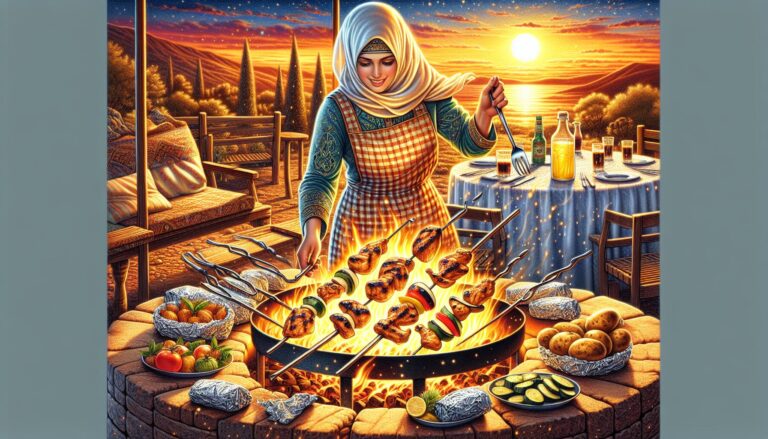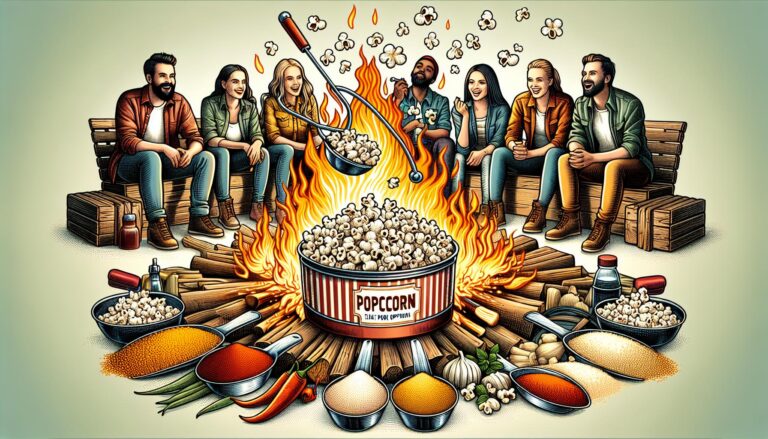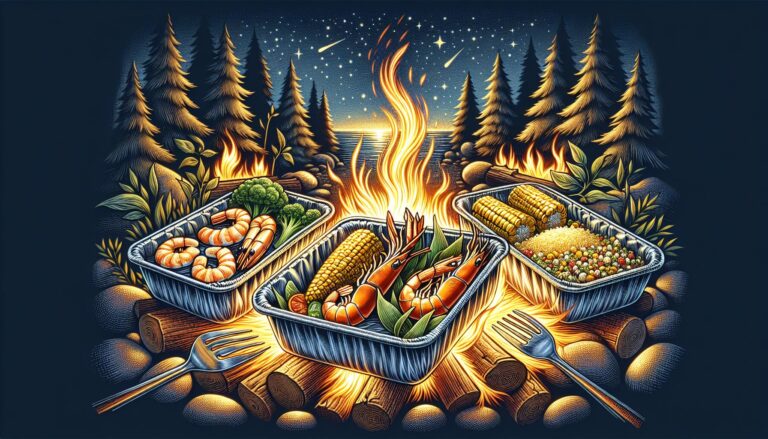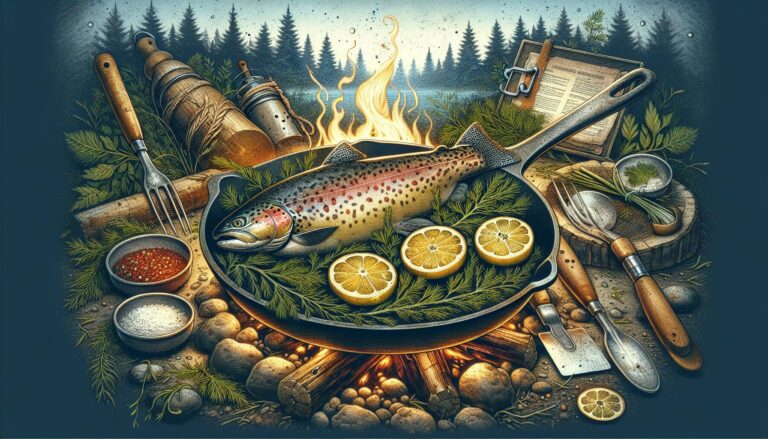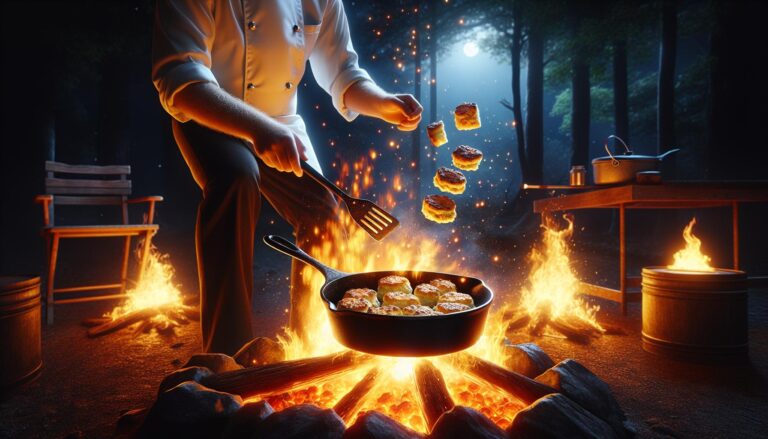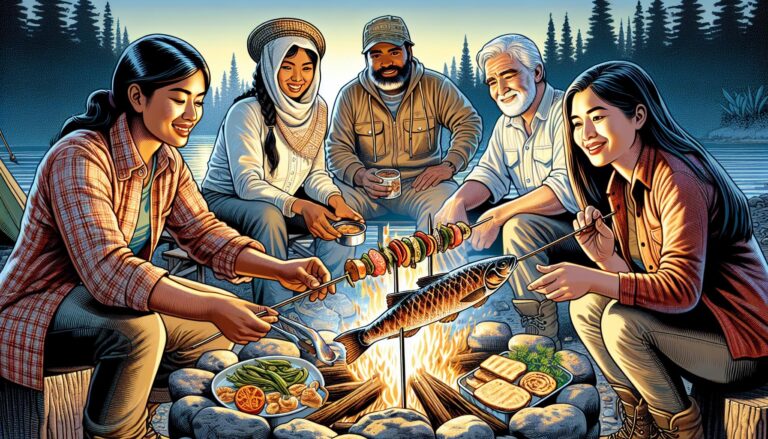Campfire Salmon Guide: Cook Perfectly Over Flames
Cooking salmon on a campfire is an art that combines the rustic charm of outdoor cooking with the delicate flavors of this sought-after fish. You’re about to learn how to perfectly grill salmon in the wild, infusing it with that irresistible smoky taste.
Imagine sitting by a crackling fire, the aroma of sizzling salmon filling the air. It’s not just a meal; it’s an experience. Whether you’re a seasoned camper or a novice, you’ll find these tips straightforward and effective for campfire cooking success.
TLDR: Get ready to master the art of cooking salmon over a campfire with simple techniques that will turn your catch into a mouthwatering outdoor feast.
Equipment needed
Campfire
You’ll need a reliable campfire to cook salmon in the wild. Start with a safe, controlled fire pit and gather dry wood to maintain a steady flame. Softwoods like pine ignite quickly and are great for kindling, while hardwoods such as oak burn slowly, creating the perfect cooking conditions. Ensure the fire is hot enough for coals to form; these embers provide a consistent heat source for cooking your salmon to perfection.
Cooking Grate or Grill
A high-quality cooking grate or portable grill is crucial for evenly cooking salmon over the campfire. Opt for a grate made from cast iron or stainless steel, as these materials withstand high temperatures and distribute heat evenly. Position the grate over the campfire, making sure it’s steady before placing your salmon on top. If you don’t have a grate, aluminum foil can be a makeshift solution—place your fish on top and let it cook over the coals.
Tongs or Spatula
To handle the salmon without flaking or tearing, you’ll want a pair of long-handled tongs or a spatula. The length is vital to keep your hands safe from the heat while turning the fish. Tongs provide a firm grip, while spatulas offer support to the entire fillet. Either way, you’ll be able to maneuver your salmon above the flames with precision and care. Remember, the key is to move the salmon as little as possible to keep it intact and ensure that smoky campfire flavor infuses every bite.
Ingredients

Cooking salmon on a campfire is a delightful experience that combines the rustic charm of the outdoors with the sumptuous taste of fresh fish. Before you can delight in the sizzling sounds and succulent flavors, you’ll need to gather the essential ingredients to ensure your success. Below, we guide you through selecting the best components for a mouthwatering campfire salmon feast.
Fresh Salmon Fillets
Choosing Fresh salmon fillets is crucial for the best outcome. Opt for fillets with a vibrant pink hue, firm texture, and a fresh, oceanic aroma. Avoid those with any browned areas or a fishy smell as these are tell-tale signs of age. When selecting the size, aim for about 6 to 8 ounces per person – just the right amount for a satisfying meal without being overly filling.
- Look for vibrant pink fillets
- Aim for a firm texture
- Estimate 6 to 8 ounces per person
Olive Oil
A key to preventing your salmon from sticking to the grill is to use Olive oil. It adds a subtle flavor and helps to create a perfect sear on the fish. Brush a moderate amount on both the fillets and the grill grate before you begin cooking. This step ensures your salmon will release easily once it’s cooked and provides a hint of Mediterranean essence to the dish.
- Brush olive oil on salmon and grill
- Prevents sticking and enhances flavor
Lemon Wedges
Lemon wedges serve a dual purpose: they add a zesty flavor and can be a charming garnish. The bright, citrusy juice not only complements the salmon’s rich flavor but also helps to cut through the natural oils, balancing the overall taste. Additionally, the acid in the lemon juice aids in tenderizing the fish. Squeeze a few drops over the cooked fillets just before serving to elevate your dish to new heights.
- Use as a flavor enhancer and garnish
- Squeeze over cooked fillets for a zesty finish
Salt and Pepper
You can’t go wrong with the classic seasoning duo of Salt and pepper. These simple seasonings bring out the natural flavors of the salmon without overpowering it. Season both sides of your fillets generously but judiciously with salt and freshly ground black pepper before placing them on the grill. This will help to form a flavorful crust that’s as pleasing to the palate as it is to the eye.
- Season with salt and freshly ground pepper
- Achieve a flavorful crust
A careful selection of these ingredients can transform your campfire salmon into a culinary delight. Make sure you have everything ready before you light the fire – having your ingredients at hand will make the cooking process smoother and more enjoyable. After gathering your ingredients, you’ll be all set to dive into the nuances of preparing and grilling your salmon to perfection. Remember, cooking outdoors has its own set of challenges, so preparation is key. Now that you’ve got your ingredients sorted let’s move on to prepping your campfire and getting that grill ready for cooking.
Preparing the fire
Building the Campfire
To create the perfect campfire for cooking your salmon, start by finding a safe, open spot away from trees, bushes, and other flammable materials. Lay down a bed of small twigs and dry leaves; these will serve as your tinder and catch fire quickly. Stack kindling, like sticks and small branches, in a tepee or log cabin structure over your tinder. Once you’ve got a solid structure, light the tinder with a match or lighter. Remember that air circulation is key, so leave enough space between the logs for the fire to breathe. As the kindling catches fire, gradually add larger pieces of wood to build a strong, lasting flame.
Letting the Fire Burn Down
Cooking salmon requires you to cook over hot embers rather than open flames; thus, patience is crucial at this stage. Let your campfire burn down to a bed of glowing coals. This process can take anywhere from 30 minutes to an hour depending on the size of your fire and the wood used. You’re aiming for a consistent heat source, which is provided by the coals evenly radiating heat. Monitor the fire as it breaks down, rotating wood as necessary to ensure an even burn. Once the larger logs have turned to embers, spread them out to create a uniform heat zone for cooking.
Positioning the Cooking Grate
If you’re using a cooking grate, place it over the glowing embers once the fire has burned down. It’s important to position the grate at the right height—too close, and you risk charring your salmon; too far, and it won’t cook through. A good rule of thumb is to hold your hand about five inches above the grate. If you can comfortably keep it there for 4-5 seconds, the heat is just right. If your cooking setup doesn’t allow you to adjust the height, you can control the temperature by spreading the embers to cool the fire or adding more coals for additional heat. Give the grate a few minutes to warm up before you place the salmon on it to ensure even cooking.
Preparing the salmon
Cleaning and Scaling the Salmon
To ensure your salmon tastes as fresh and delectable as possible, start by cleaning and scaling it. First, rinse the fish under cold running water to wash away any debris or slime. Next, using a scaling tool or the back of a knife, scrape against the grain of the fish’s scales from tail to head. Be gentle but thorough—leftover scales can affect the texture and taste. After scaling, remove the innards if your salmon isn’t already gutted. Rinse the cavity and exterior once more to make sure it’s completely clean.
Seasoning the Salmon
Seasoning is critical for bringing out the robust flavors of the salmon. Lay the fish flat and dab it dry with paper towels. Then, brush the salmon with a thin coat of oil; this will act as a glue for your seasonings and help prevent sticking to the grate. Choose your preferred herbs and spices—options like dill, lemon zest, garlic, and salt are classics for a reason. Sprinkle your seasoning mix evenly over the salmon, inside and out. For an aromatic twist, consider adding slices of citrus or herbs directly into the fish cavity.
Letting the Salmon Come to Room Temperature
Before the salmon meets the campfire, it’s important to let it rest at room temperature for 10-15 minutes. This step is key in ensuring even cooking. Cold fish from the icebox will drop the temperature of your cooking surface, leading to longer cooking times and potentially unevenly cooked fish. While the salmon rests, you can prep your cooking tools or simply enjoy the ambience of your campsite. But keep an eye on the time—too long at warm temperatures and the fish could begin to spoil.
Cooking the salmon
Once your salmon has reached room temperature and is properly seasoned, it’s time to introduce it to the heat. Cooking salmon over a campfire brings out a delicious, smoky flavor that’s hard to replicate with other cooking methods. To ensure your fish cooks evenly and doesn’t stick, you’ll need to follow a few key steps.
Oil the Cooking Grate
Before you place the salmon on the grill, make sure your cooking grate is well-oiled. This is crucial for several reasons:
- Prevents sticking: Salmon skin tends to adhere to the grate without proper lubrication.
- Helps achieve a crispy skin: Oil can help to crisp up the skin, adding texture and flavor.
- Easier flipping: When it’s time to turn your salmon, oiling the grate makes the process much smoother.
You can use a paper towel soaked in high-smoke-point oil like canola or vegetable oil to rub over the grates. Be thorough but don’t overdo it – a thin coat will suffice.
Placing the Salmon on the Grill
When placing the salmon on the grill, there are a few techniques to keep in mind:
- Position the salmon diagonally across the grates for beautiful grill marks.
- Lay it skin-side down first; this protects the delicate flesh from the flames and helps to lock in flavors.
- Don’t overcrowd the grill. Salmon needs space for heat to circulate properly.
Be gentle when placing your seasoned fish onto the grill to maintain its shape and integrity. Once it’s in position, resist the urge to move it. Doing so before it’s time can cause the fish to tear.
Cooking Time and Temperature
Cooking salmon perfectly requires attention to timing and temperature. Here’s a basic guide to get you started:
| Doneness | Internal Temperature | Cooking Time (per side) |
|---|---|---|
| Medium rare | 125°F – 130°F | 4-5 minutes |
| Medium | 130°F – 135°F | 5-6 minutes |
| Well-done | Over 140°F | 6-8 minutes |
To maintain a consistent temperature:
- Keep a moderate flame; too high will char the exterior before cooking the inside.
- Use a meat thermometer to check doneness.
- Flip the fish only once, halfway through the cooking time, to avoids flaking and drying out.
Remember, the salmon will continue to cook slightly after you remove it from the grill due to residual heat, so account for that when checking its temperature.
Using these techniques, you’ll find the salmon doesn’t just feed your hunger; it satisfies your love for the great outdoors and good food. With every bite, you’ll taste the care and precision you’ve put into each step of the cooking process. Enjoy the flavors, embrace the smokiness, and revel in the satisfaction of a perfectly cooked campfire salmon.
Checking for doneness
Cooking salmon on a campfire can be a rewarding experience, but knowing when your fish is just right takes a bit of skill. To help you achieve that perfectly cooked piece of salmon, you’ll need to look for specific signs that signal it’s ready to come off the grill.
Flaky Texture
One of the telltale signs your salmon is done is its texture. When cooked, the flesh of the salmon should easily flake apart with a fork. Gently press down on the top of the fillet with your utensil—if it separates along the natural lines of the fish without resistance, your salmon has likely reached the perfect level of doneness.
- Look for separation along the flesh lines
- Use a fork to test flakiness
Translucent Appearance
The appearance of your salmon changes dramatically as it cooks. You’ll start with a raw, translucent fish that’s rather slick. As it cooks over the campfire, the color will deepen, and the flesh will become more opaque. Yet, it’s vital not to wait until it’s completely opaque, as that could mean it’s overdone. Instead, aim for a primarily opaque exterior with just a slight translucency at the thickest part of the fillet. This balance indicates your salmon is cooked through but still moist and tender inside.
- Watch as the salmon’s color darkens
- Aim for an opaque exterior with slight translucency
Internal Temperature
Using a meat thermometer is the most foolproof method to ensure your salmon is cooked perfectly. The ideal internal temperature for salmon is 145°F (62°C), according to the USDA. However, some chefs recommend pulling it off the fire slightly before it reaches this temperature, as the residual heat will continue cooking the fish. Insert the thermometer into the thickest part of the fillet, careful not to hit any bones, to get an accurate reading.
| Doneness Level | Internal Temperature |
|---|---|
| Medium-Rare | 125°F – 130°F |
| Medium | 135°F – 140°F |
| USDA Recommended | 145°F |
- Use a meat thermometer
- Insert in the thickest part
- Consider residual heat effect
Make sure to monitor your campfire-cooked salmon closely. The transition from done to overdone can happen quickly, and since each campfire’s heat can vary, relying on these indicators rather than just time ensures you’ll have a dish worth remembering. Remember, a well-cooked salmon translates not just to an enjoyable meal, but also to a campfire experience that’s full of flavor and satisfaction.
Serving and enjoying
Once your salmon is cooked to perfection, there’s nothing left to do but serve it up and enjoy the fruits of your campfire cooking labor. This portion of the article will guide you on how to elevate your campfire salmon to the next level with simple yet effective serving techniques.
Squeezing Lemon Juice Over the Salmon
A little lemon juice goes a long way. Squeezing a bit of lemon over your cooked salmon isn’t just a chef’s trick for restaurants; it’s a campfire game-changer. The bright acidity of lemon brings out the salmon’s rich flavors, enhancing your meal without overwhelming it. Just cut a lemon into wedges and give them a gentle squeeze over your fish. The lemon’s zest will infuse the salmon with a refreshing citrus note that pairs perfectly with the smokey nuances from the campfire.
Accompaniments and Side Dishes
No meal is complete without side dishes, and your campfire salmon is no exception. Think about options that are easily prepared outdoors:
- Grilled Vegetables: Bell peppers, zucchini, and asparagus are great when charred over the campfire.
- Roasted Potatoes: Wrap them in foil and place them in the coals to cook alongside your salmon.
- Simple Salads: Toss together a salad of mixed greens with a vinaigrette that can be prepped ahead of time.
Choosing the right side dishes will balance the meal and ensure you’re getting a range of flavors and nutrients.
Storing Leftovers
If you find yourself with more salmon than you can eat, don’t let it go to waste. Storing leftovers properly is crucial. Once the salmon has cooled, place it in an airtight container and refrigerate. Properly stored, cooked salmon should be consumed within two days for optimal freshness and safety. Remember, reheat only what you’ll be eating, as repeated warming can dry out the fish and degrade its quality.
Conclusion
Mastering the art of cooking salmon over a campfire can elevate your outdoor dining to new heights. Remember to keep an eye on the fish’s texture and color for the perfect flake and to use a meat thermometer for precision. With the right touch, your salmon will come off the fire juicy and flavorful, ready to be enhanced with a squeeze of lemon. Pair it with your favorite sides and enjoy the fruits of your labor under the open sky. And if you find yourself with leftovers, they’ll be just as delicious the next day, provided you store them correctly. Now that you’ve got the know-how, it’s time to stoke the flames and get grilling!
Frequently Asked Questions
How do you check if salmon is properly cooked over a campfire?
To determine if salmon is properly cooked, the texture should flake easily with a fork. Additionally, the salmon should appear more opaque but with a slight translucence in the thickest part. Using a meat thermometer, ensure the internal temperature reaches 145°F (62°C) or slightly less to account for residual heat.
What is the ideal internal temperature for cooked salmon?
The ideal internal temperature for cooked salmon is 145°F (62°C), taking into account that the fish will continue to cook from residual heat after removal from the campfire.
How do you avoid overcooking salmon on a campfire?
Avoid overcooking salmon by monitoring it closely and using the flaking test or a meat thermometer to guide doneness. Remove the salmon right before it reaches the desired doneness, considering the residual heat will finish the cooking process.
What are some good side dishes to serve with campfire-cooked salmon?
Good side dishes for campfire-cooked salmon include grilled vegetables, roasted potatoes, and simple salads. These complement the flavors of the salmon and contribute to a well-rounded meal.
How should you store leftover salmon?
To store leftover salmon, allow it to cool and then place it in an airtight container. Refrigerate it promptly and consume within 1-2 days for optimal freshness and safety.

